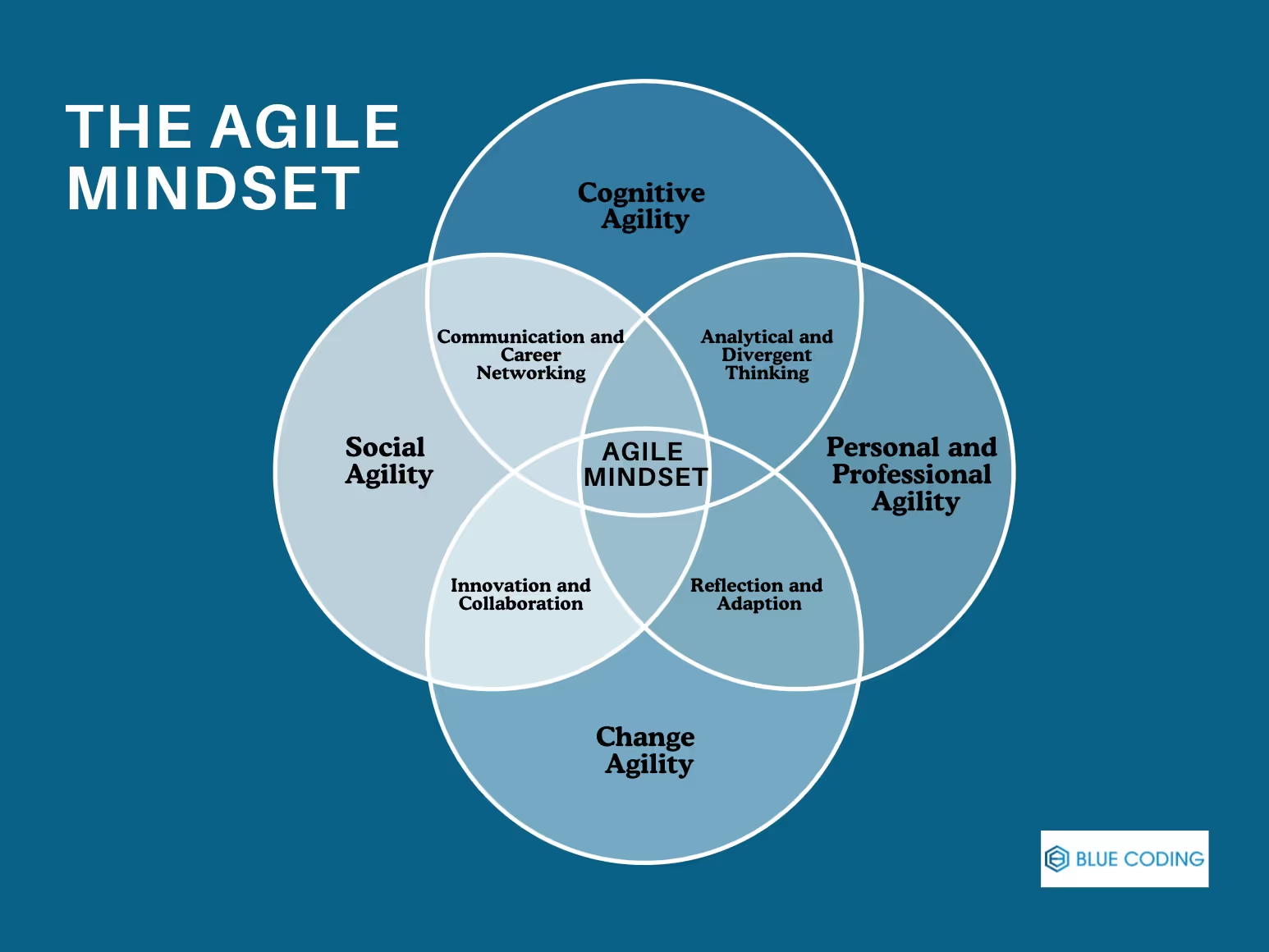Learn how to foster an agile mindset in your nearshore development team so you can boost collaboration, adaptability, and productivity with proven strategies inside your development teams!


Building an Agile mindset takes time, patience, and consistent effort. It helps teams adapt to changes, work efficiently, and improve collaboration. An Agile approach also promotes better communication and encourages continuous learning. For nearshore development teams, adopting this mindset can bridge gaps and strengthen teamwork. By following these tips, your nearshore development team can become more flexible, collaborative, and focused on delivering excellent results.


An Agile mindset helps remote software development teams stay flexible, focused, and productive. It improves project results while also creating a positive and collaborative team environment. Let’s explore more reasons that make Agile mindset elements crucial.
An Agile mindset encourages team members to embrace and adapt to change quickly. In remote work environments, unexpected challenges such as shifting priorities or technical issues can arise. Agile software development practices help teams stay flexible, adjust goals, and implement changes without losing momentum. This adaptability is crucial for meeting deadlines and delivering quality results.
Agile promotes open communication and collaboration among team members. For remote teams, tools like video conferencing, chat platforms, and shared workspaces become essential to foster interaction. Regular stand-ups, retrospectives, and planning sessions ensure everyone is aligned, even when working across different time zones. This continuous collaboration helps in building trust and cohesion within the team.
Remote teams can sometimes lose sight of customer expectations due to physical distance and lack of direct interaction. An Agile mindset prioritizes customer satisfaction by focusing on iterative development and frequent feedback loops. This approach ensures that the team delivers features that truly meet customer needs, reducing the risk of misaligned goals.
In nearshore Agile development teams, individuals are encouraged to take ownership of their tasks and deliverables. This principle is particularly important in remote setups, where supervision is limited. Agile empowers team members to manage their time effectively, meet commitments, and contribute proactively to the team’s success.
Nearshore Agile development practices like retrospectives encourage teams to regularly review their performance and identify areas for improvement. For remote teams, this process helps in addressing challenges such as communication gaps, workflow inefficiencies, or tool mismatches. By focusing on continuous improvement, remote teams can enhance productivity and maintain high performance over time.
Working remotely can sometimes feel isolating, leading to decreased motivation. An Agile mindset fosters a supportive and inclusive environment where everyone’s input is valued. Celebrating small wins, sharing progress, and overcoming obstacles together boost team morale and create a sense of belonging, even from afar.
Adopting an Agile mindset in a nearshore development team can greatly improve productivity, flexibility, and teamwork. It helps the team adapt to changes, work efficiently, and deliver better results. Below are practical tips to help your team develop an Agile mindset.
Strong communication is at the heart of an Agile software development team. Nearshore teams, working in overlapping time zones, are well-placed to hold real-time discussions. To maintain clarity, schedule daily stand-up meetings, weekly updates, and open discussions for sharing ideas or solving problems. Use tools like Slack or Microsoft Teams to ensure communication flows smoothly throughout the day. When everyone feels connected and heard, it builds trust and strengthens collaboration. You can also use video calls for more personal discussions and asynchronous tools like email for updates that don't need immediate replies. This mix ensures the team remains on the same page while accommodating different working styles.
One of the key principles of Agile software development is working in small, manageable parts called sprints. Instead of tackling large, overwhelming tasks, divide them into smaller milestones. This makes it easier to track progress and spot any issues early. For example, if the project involves building a website, break it into tasks like designing the homepage, developing the backend, and testing functionalities. Nearshore teams can benefit from this structure because it allows them to deliver updates frequently, giving clients confidence in the progress. It also encourages continuous improvement, as each sprint ends with a chance to evaluate and adjust.
In Agile teams, every member plays a crucial role. Make sure tasks are assigned clearly so everyone knows what they are responsible for. This could be as simple as creating a shared task board where each team member updates their progress. When people feel ownership of their tasks, they are more motivated to meet deadlines and deliver high-quality work. Encourage team members to share updates during daily stand-ups and reflect on their performance during retrospectives. This builds a sense of accountability and helps everyone understand how their work contributes to the overall project.
Flexibility is a core aspect of an Agile mindset. In software development, priorities often shift due to client feedback or new requirements. Teach your nearshore team to embrace change rather than resist it. This can involve regularly reviewing priorities and updating sprint plans to reflect the new direction. For example, if a client decides to change the design halfway through the project, an Agile team will adjust tasks accordingly rather than seeing it as a setback. This ability to adapt quickly helps the team stay relevant and focused on client needs.
Agile is all about teamwork. Developers, testers, designers, and other roles need to work together closely. Use Agile practices like planning meetings and retrospectives to bring the team together. Make sure everyone has a voice, regardless of their role. For nearshore teams, collaboration can be strengthened by using tools like Trello or Jira to share progress and manage tasks. When the whole team works toward the same goal, it reduces misunderstandings and speeds up problem-solving.
Agile teams thrive on learning and improving. Encourage your team to take training courses, share knowledge with each other, or attend workshops. After every sprint, hold a retrospective meeting to reflect on what went well and what can be improved. For example, if a particular tool is slowing down development, the team can explore alternatives in the next sprint. This culture of constant learning keeps the team motivated and helps them stay ahead of challenges.
Trust is essential in Agile teams. Show your nearshore team that you value their expertise by involving them in decisions and listening to their ideas. Avoid micromanaging and instead focus on empowering them to find creative solutions. For instance, give your developers the freedom to choose the best tools or methods for completing their tasks. When people feel trusted, they are more confident in their abilities and more committed to delivering great results.
Using the right tools can make Agile practices easier to follow. Project management tools like Jira or Trello help track tasks, while communication platforms like Zoom or Slack ensure team members stay connected. Version control systems like GitHub or Bitbucket are essential for managing code. Ensure that everyone on the team knows how to use these tools effectively. Having the right resources not only simplifies workflows but also helps the team focus on what matters most, delivering value.
Celebrating milestones, big or small, boosts team morale and motivation. Whether it's finishing a sprint, solving a tricky problem, or delivering a project phase on time, take the time to recognize these achievements. For remote teams, even simple gestures like a shoutout during a meeting or a thank-you email can make a big difference. Celebrations remind the team of their hard work and create a positive atmosphere.
Feedback is an important part of Agile. Ask your team and clients for their input regularly. For example, hold end-of-sprint meetings to discuss what worked well and what could be improved. For clients, short feedback sessions during project updates can provide valuable insights. Make sure to act on the feedback you receive. When team members see their suggestions being implemented, it shows that their voices matter. This motivates them to stay engaged and committed to the Agile process.
Help your team understand the bigger picture of Agile. Explain how it focuses on delivering value, adapting to change, and working as a team. When your nearshore team understands why Agile practices are important, they are more likely to embrace the mindset fully.
Whether you want to hire Agile software developers, Java developers, or Ruby on Rails developers, the process of finding and shortlisting the right candidate is extremely challenging. This is why companies work with nearshore outsourcing agencies, such as Blue Coding, so they can hand over their entire responsibility of finding the right developers to them while they themselves can focus on their core business goals. To learn more about how we can help you specifically, contact us now and book your free discovery call!
Subscribe to our blog and get the latest articles, insights, and industry updates delivered straight to your inbox